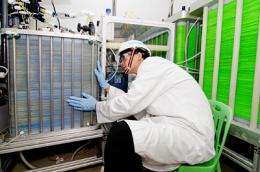Desalinating seawater with minimal energy use

At a pilot facility in Singapore, Siemens has cut the energy needed to desalinate seawater by more than 50 percent. The plant processes 50 cubic meters of water per day, consuming only 1.5 kilowatt-hours of electricity per cubic meter. The most efficient desalination technique currently in use is reverse osmosis, which consumes more than twice as much energy. The magazine "Pictures of the Future" reports that the new technique uses an electric field to remove the salt from the water. Plans call for demonstration units to be set up in Singapore, the U.S., and the Caribbean by mid-2012.
Experts estimate that global water consumption will rise by 40 percent over the next 15 years. Because desert countries and small nations such as Singapore have few sources of fresh water, they are increasingly desalinating seawater, which still consumes a lot of energy. Turning one cubic meter of seawater into steam takes about 10 kilowatt-hours of electricity. By contrast, reverse osmosis, which presses the water through a filter, consumes about four kilowatt-hours for the same amount of water.
The new energy-saving system from Siemens uses electrodialysis. It extracts the salts’ positively and negatively charged ions from the water by means of an electric field. Special membranes that only allow a single type of ion to pass through create channels that collect either the resulting brine or the purified water. However, the process becomes inefficient as the salt concentration declines because the water’s electrical resistance increases. That’s why a Continuous Electrodeionization (CEDI) system is used to extract the last percentage of salt in the water. In this system, ion exchange resins located between the membranes capture the ions and transport them away from the water.
Experts from Siemens Corporate Technology are currently working on a simulation model that will help further improve the process. As part of a project sponsored by the German Research Ministry, the researchers will simulate the processes at the molecular level. They hope the model will help them to better understand the transport of the ions through the membranes as well as the dynamics of the water flow in the electric field.
Siemens developed the new desalination technique at the Singapore WaterHub, a research center for water treatment systems. The technology is part of Siemens’ Environmental Portfolio, with which the company generated about €28 billion in sales in fiscal year 2010.
Provided by Siemens




















